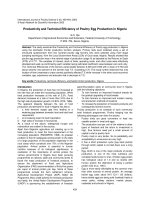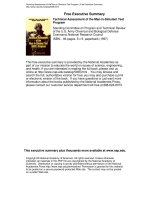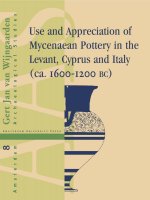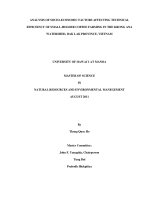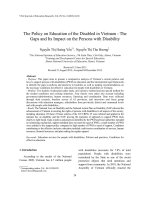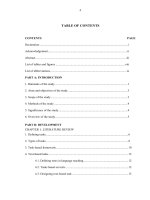Technical efficiency of poultry farms in vietnam non parametric and parametric approaches
Bạn đang xem bản rút gọn của tài liệu. Xem và tải ngay bản đầy đủ của tài liệu tại đây (1.38 MB, 94 trang )
UNIVERSITY OF ECONOMICS
HO CHI MINH CITY
VIETNAM
INSTITUTE OF SOCIAL STUDIES
THE HAGUE
THE NETHERLANDS
VIETNAM - NETHERLANDS
PROGRAMME FOR M.A IN DEVELOPMENT ECONOMICS
TECHNICAL EFFICIENCY OF
POULTRY FARMS IN VIETNAM
NON-PARAMETRIC AND PARAMETRIC APPROACHES
BY
NGUYỄN THỊ NGỌC LINH
MASTER OF ARTS IN DEVELOPMENT ECONOMICS
HO CHI MINH CITY, DECEMBER 2013
UNIVERSITY OF ECONOMICS
HO CHI MINH CITY
VIETNAM
INSTITUTE OF SOCIAL STUDIES
THE HAGUE
THE NETHERLANDS
VIETNAM - NETHERLANDS
PROGRAMME FOR M.A IN DEVELOPMENT ECONOMICS
TECHNICAL EFFICIENCY OF
POULTRY FARMS IN VIETNAM
NON-PARAMETRIC AND PARAMETRIC APPROACHES
A thesis submitted in partial fulfilment of the requirements for the degree of
MASTER OF ARTS IN DEVELOPMENT ECONOMICS
BY
NGUYỄN THỊ NGỌC LINH
Academic Supervisor:
DR. TRƢƠNG ĐĂNG THỤY
Ho Chi Minh City, December 2013
DECLARATION
This is to certify that the thesis entitle “Technical efficiency of Vietnam poultry farms:
non-parametric and parametric approaches”, which is submitted by me in partial
fulfillment of the requirement for the degree of Master of Art in Development
Economic to Vietnam – The Netherlands Programme. The thesis comprises only my
original work and due supervision and acknowledgement have been made in the text to
all materials used.
Nguyễn Thị Ngọc Linh
i
ACKNOWLEDGEMENT
My appreciation firstly goes to my supervisor, Dr. Trƣơng Đăng Thụy, who has made a
great effort to support me in this thesis. His profound comments have been helpful not
only in completing this study but also in improving my knowledge in doing the
research.
I would like to thank my family, especially my mother. I would not complete this
thesis, as well as study in this program, without their scarification, encouragement and
important support. For the love and expectation of my family, which motivate my
effort to complete this master degree, my mere expression of gratitude here have
never been sufficient.
I am very proud to attend this program. I am grateful to all lectures in Vietnam –
Netherlands Programme for their dedicated instruction and all the courses during the
period I studied at the program. Besides, I would like to thank all the academic and
technical staffs of the Vietnam – Netherlands Programme for supporting me during that
time.
Moreover, I received the enormous encouragement from my classmates and
workmates, especially my special friend who has supported me a lot in the writing
process. I am very grateful for everything that all of you gave me.
ii
ABBREVIATION
AE
Allocative efficiency
BCC
DEA model as study of Banker, Charnes and Cooper
CCR
DEA model as study of Charnes, Cooper and Rhodes
CRS
Constant returns to scale
DEA
Data Envelopment Analysis
DMU
Decision making unit
DPF
Deterministic Production Function
FAO
Food and Agriculture Organization
GSO
General Statistic Office
ML
Maximum likelihood
MLE
Maximum likelihood estimate
OLS
Ordinary Least Square
Probability density function
SFM
Stochastic Frontier Model
TE
Technical efficiency
VHLSS
Vietnam Household Living Standards Survey
VND
Vietnam Dong
VRS
Variable returns to scale
iii
ABSTRACT
This study attempts to estimate the technical efficiency as well as determine the
factorial effects of technical efficiency level of Vietnam poultry farms under semiindustrial system and traditional system. Then, this study employs a two-stage analysis
with a household-level dataset in whole country. In particular, the first stage estimates
technical efficiency level of poultry farms under both systems through non-parametric
and parametric approaches, which were represented by Data Envelopment Analysis and
Stochastic Frontier Analysis, respectively. In the second stage, sources of efficiency
will be determined by Tobit regression and least square regression with householdspecific characteristics which represent for human capital in qualitative dimension. A
sample of 3,356 households in VHLSS 2010 is utilized to analyze the broiler poultry
production in Vietnam, wherein 820 poultry farms under semi-industrial system and
2,536 poultry farms under traditional system. The results from the first stage show that
the average technical efficiency which was obtained from SFM is higher than that in
DEA; and the TE scores in SFA exhibit the variability lower than TE scores in DEA.
Moreover, from the analysis in the second stage, it is can be stated that education level
of farmer has significantly effects on the TE differential among poultry farms in the
positive way. Finally, the results also show that TE scores of poultry farms under both
systems located in the Southeast are higher than other agro-ecological regions.
Keywords: poultry household, data envelopment analysis, stochastic frontier model,
technical efficiency, human capital.
iv
TABLE OF CONTENTS
CHAPTER 1: INTRODUCTION .................................................................................... 1
1.1 Problem Statements ................................................................................................ 1
1.2 Research Objectives ............................................................................................... 4
1.3 Research Organization ............................................................................................ 5
CHAPTER 2: LITERATURE REVIEW ......................................................................... 6
2.1 Basic concepts of efficiency ................................................................................... 6
2.2 Data Envelopment Analysis (DEA) and Stochastic Frontier Analysis (SFA) ....... 9
2.2.1 Data Envelopment Analysis (DEA) ............................................................... 10
2.2.2 Stochastic Frontier Model approach (SFM)................................................... 12
2.2.2.1 The Production frontier ........................................................................... 12
i. Deterministic Production Frontier ................................................................ 12
ii. Stochastic Production Frontier .................................................................... 13
2.2.2.2 Estimation method................................................................................... 15
i. Modified Ordinary Least Squares (MOLS) .................................................. 15
ii. Maximum likelihood Estimation (MLE) ..................................................... 16
2.2.2.3 Measurement of Efficiency ..................................................................... 17
2.2.3. Comparison between DEA and SFM approaches ......................................... 17
2.3 Empirical studies .................................................................................................. 19
2.3.1 Measurement of technical efficiency of poultry subsector ............................ 19
2.3.2 DEA and SFM approaches on measurement of technical efficiency of
agriculture sector ..................................................................................................... 22
2.3.3 Impact of human capital on agriculture productivity ..................................... 24
CHAPTER 3: OVER VIEW OF POULTRY FARMS IN VIETNAM ......................... 27
3.1 General characteristics of poultry production in Vietnam .................................... 27
3.2 Poultry production system in Vietnam ................................................................. 29
i. Traditional extensive household poultry production (non-intensive system) ...... 31
ii. Semi-industrial commercial poultry production (semi-intensive) ...................... 32
iii. Industrial poultry production (intensive system) ............................................... 32
v
CHAPTER 4: DATA DESCRIPTIONS AND RESEARCH METHODOLOGY ......... 34
4.1 Data Description ................................................................................................... 34
4.1.1 Data Source .................................................................................................... 34
4.1.2 Data Descriptions ........................................................................................... 34
4.2 Method, Model specification and Variables definition ........................................ 36
4.2.1 The first stage: Measurement of Technical efficiency ................................... 36
4.2.1.1 Measurement of Technical efficiency using Data Envelopment Analysis
............................................................................................................................. 36
4.2.1.2 Measurement of Technical efficiency using Stochastic Frontier Model . 38
i. Production function specification ................................................................. 39
ii. Estimation method specification ................................................................. 40
4.2.1.3 Variables Description for the first stage .................................................. 41
4.2.1.4 Hypothesis testing ................................................................................... 44
i. Functional form specification test ................................................................ 45
ii. Estimating method specification test ........................................................... 45
4.2.2 The second stage: Factorial decomposition of Technical efficiency ............. 46
4.2.2.1 The Technical efficiency model .............................................................. 46
4.2.2.2 Variables description for the second stage .............................................. 49
4.2.3 Research Hypotheses ..................................................................................... 53
CHAPTER 5: EMPIRICAL RESULTS AND DISSCUSION ...................................... 54
5.1 The first stage: The estimation of the Technical efficiency scores ...................... 54
5.1.1 Testing null hypotheses for SFM approach in the first stage ......................... 54
i. The Production Functional form specification test .......................................... 55
ii. The model specification test ........................................................................... 57
5.1.2 Discussion on results obtained from the first stage........................................ 58
5.1.2.1 Comparing the Technical efficiency scores in SFM and DEA approaches
............................................................................................................................. 58
5.1.2.2 The distribution of technical efficiency scores in SFM and DEA
approaches ........................................................................................................... 60
5.1.2.3 Technical efficiency varies between agro-ecological regions ................. 63
vi
5.2 The second stage: The determinants of Technical efficiency............................... 65
5.2.1 Testing the significant of coefficients simultaneously for regressions .......... 65
5.2.2 Discussion on the results obtained from the second stage ............................. 66
5.2.2.1 The effects of human capital on technical efficiency scores ................... 67
5.2.2.2 The difference of technical efficiency scores between various agroecological regions ................................................................................................ 69
CHAPTER 6: CONCLUSION AND POLICY IMPLICATION ................................... 70
6.1 Concluding remarks .............................................................................................. 71
6.2 Policy implications ............................................................................................... 72
6.3 Limitations of study and recommendations for future research ........................... 73
REFERENCES ............................................................................................................... 74
Appendix 1: Matrix of correlation between variables in Stochastic frontier production
function of semi-industrial poultry farms ....................................................................... 78
Appendix 2: Matrix of correlation between variables in Stochastic frontier production
function of traditional poultry farms .............................................................................. 78
Appendix 3: Matrix of correlation between variables in technical efficiency model of
semi-industrial poultry farms ......................................................................................... 79
Appendix 4: Matrix of correlation between variables in technical efficiency model of
traditional poultry farms ................................................................................................. 79
Appendix 5: OLS regression of technical efficiency model of traditional poultry farms
........................................................................................................................................ 80
Appendix 6: Testing heteroskedasticity for OLS regression of technical efficiency
model of traditional poultry farms ................................................................................ 80
Appendix 7: Testing heteroskedasticity for OLS-robust regression of technical
efficiency model of traditional poultry farms ................................................................ 81
Appendix 8: Summary of Empirical Studies at measuring technical efficiency of
poultry sector .................................................................................................................. 82
Appendix 9: Summary empirical studies of comparison DEA and SFM approaches at
measuring the technical efficiency ................................................................................. 84
vii
LIST OF TABLES
Table 4-1: Summary statistic of broiler poultry productivity of farms between regions
and within systems ......................................................................................................... 35
Table 4-2: Summary statistic of Input and Output variables for Poultry farms under
semi-industrial system and traditional system ............................................................... 42
Table 4-3: Statistical description of determinant factors of technical efficiency level .. 52
Table 5-1: Maximum-likelihood estimates of the Cobb-Douglas and Translog
stochastic production frontier models ............................................................................ 56
Table 5-2: Tests hypotheses of the production function specification ........................... 58
Table 5-3: Summarizing the technical efficiency scores ............................................... 59
Table 5-4: The technical efficiency distribution in SFM and DEA-BCC ...................... 61
Table 5-5: Technical efficiency scores among agro-ecological regions ........................ 63
Table 5-6: The factorial effects on technical efficiency scores from SFM and DEABCC ................................................................................................................................ 66
LIST OF FIGURES
Figure 2-1: Technical efficiency and Allocative Efficiency ............................................ 8
Figure 2-2: Stochastic Production Frontier .................................................................... 14
Figure 3-1: Growth rate of livestock and poultry with base year of 1990 ..................... 27
Figure 3-2: Annual growth rate of number of poultry with base year of 1990 .............. 28
Figure 3-3: Poultry density of Vietnam in 2006 ............................................................ 29
Figure 3-4: Average number of birds per household in 2001 ........................................ 29
Figure 3-5: Regional Characteristics of poultry-holding household in 2002 ................ 30
Figure 3-6: Proportion of total chicken in three production systems in 2006 and 2009 in
Vietnam .......................................................................................................................... 33
Figure 5-1: The distribution of TE scores of semi-industrial and traditional systems
from SFM and DEA approaches .................................................................................... 62
Figure 5-2: Technical efficiency scores between agro-ecological regions .................... 64
viii
CHAPTER 1
INTRODUCTION
1.1 Problem Statements
In the period from 1971 to 1995, the dramatically increasing consumption demand for
livestock and production of livestock named “Livestock Revolution” had a remarkable
contribution to socio-economic development in developing countries, especially in
agriculture sector (Delgado et al., 1999). The benefits from livestock subsector were
analyzed in many aspects including ensuring food security, reducing unemployment
and alleviating poverty in rural areas, and supplying materials for other sectors both in
industry and in agriculture (Delgado et al., 1999; Upton, 2004). Besides, poultry raising
subsector has some advantages compared to other livestock subsectors such as the high
rate of reproduction and the quick return on capital investment while a large area is not
required. Therefore, the poor households can keep a dozen of chickens (Sugiyama et
al., 2003).
Similarly, in Vietnamese villages, poultry is one of the most common products and
becomes more and more popular because of its advantages. Poultry production
increases more rapidly than other animal raising ones. In particular, the annual growth
of head count in poultry is 5% higher than the 2% average growth rate of livestock
sector in the period from 1990 to 2010. Furthermore, national poultry population is well
developed across the country, mainly in the North regions which comprises around
78% of total poultry population; and the proportion of poultry keeping households rises
sharply from nearly 64% in 2001 to 90% of all rural households in 2010 (GSO, 2011).
The popularity of poultry keeping households indicates that poultry production
becomes an important resource; it may play a significant role in enhancing living
standards such as raising income, creating jobs or improving human nutrition in
Vietnamese rural areas. However, a remaining puzzle is whether farmers can expand
poultry production without an increase in investment or flock size of birds since most
poultry keeping households in Vietnam rely on the traditional system. In other words,
the fact raises a question for farmer and policy maker on how to produce maximal
1
output at limited resources in their production process. Given the foregoing problems,
analyzing technical efficiency of poultry farms is helpful to improve rural livelihood.
The efficiency concept was first presented by Koopmans (1951) that decision making
units (DMU) obtain efficiency point when they produce maximal outputs at a given
level of inputs or require the minimal inputs to produce a given level of outputs. The
aggregate combination of optimal output that can be obtained at a given input level is
the production frontier. The technical efficiency level of a DMU is estimated by the
distance from the observed output to the production frontier.
Since then, the technical efficiency concept has become the axiom of latter studies in
measuring efficiency level of DMU such as pioneering works of Farrell (1957). The
theory of Farrell has been extensively developed by many researchers in two separate
lines of research: the non-parametric and parametric approaches. In particular, nonparametric approach is a mathematical programming technique represented by Data
Envelopment Analysis while parametric approach is an econometric method
represented by Stochastic Frontier Model. These two methods are leading approaches
in the measurement of efficiency and have their own advantages and disadvantages.
Nevertheless, using which method to estimate technical efficiency is still in debate,
especially in agriculture sector. Some authors prefer parametric approach (Alabi and
Aruna, 2005; Tung and Rasmussen, 2005; Ike, 2011; Ohajianya et al., 2013) while
other prefer non-parametric approach (Heidari et al., 2011, Jatto et al., 2012, Rafiee et
al., 2013). Other researchers, possibly for caution, want to compare the results from the
two approaches (Wadud and White, 2000; Theodoridis and Psychoudakis, 2008; and
Zamanian et al.. 2013).
There exists an active line of research in analyzing technical efficiency of the
agriculture sector in Vietnam. However, most of the studies focus on crop subsector
while livestock and other subsectors, especially the poultry are somewhat neglected.
Hanh et al. (2007) classified poultry production in Vietnam into three categories based
on the definition of Food and Agriculture Organization consisting of traditional, semiindustrial and industrial system. Specifically, proportion of households raising poultry
under traditional system is largest and accounts for 75% while the average income is
lowest at 1.5million VND per household per year (VHLSS 2010). In contrast, poultry
2
households under industrial system account for only 0.44% but the average income is
over 250million VND per house per year (VHLSS 2010). The large gap of income
between traditional, semi-industrial systems and industrial system may be explained by
the application of different technologies of poultry keeping households during their
production process. Apart from that, poultry households located in different ecological
regions have various comparative advantages, which also affect poultry farmers’
technical efficiency level.
In addition, Tian and Wan (2000) stated that in agriculture sector, there are three main
types of factors which affecting the technical efficiency including biological factors,
human resources, and socioeconomic conditions. Firstly, biological factors are
indicated by the specifications of varietal attributes, soil, and characteristics of each
agricultural sector such as production system and seasonal crop. Moreover, the
difference of technical efficiency levels among farms is also explained by human
resources. Human resources were classified in quantitative and qualitative dimensions
by Schultz (1961). Specifically, the quantitative dimension or the physical factor was
represented by number of labor, working day or working hours of labor, whereas the
qualitative dimension or the human capital factor was defined by intrinsic attributes of
labor which were invested by themselves in their leisure time such as skill, education,
experience and other characteristics. He argued that the failure of classical production
function is that the human resource was treated as a produced means of production
regardless of knowledge and skill of labor, while quality of labor force can greatly
improve the productivity of firm. Finally, socioeconomic conditions also influence the
technical efficiency through the status of economic development, policy and
institutional setting supporting for farmers. In this study, due to data limitations, only
the human capital factor was considered as the explanatory factor of technically
efficient differentials among farms due to data limitations.
In general, the quality of rural labor force tends to suffer due to the massive migration
of farm labors to big cities. There is an imbalanced distribution of labor force between
urban and rural regions that labor force in rural areas is much higher than in urban areas
in terms of quantity. According to GSO, rural population in 2010 is more than 70% of
the total population but high-quality labor tends to transition to urban areas because the
education level of rural labors is lower. Huffman (2001) suggested that when the
3
environment of industry, including technology and price volatility, is left unchanged,
especially in agriculture sector, experience is important, even more important than
education in improving the productivity. However, agriculture environment always
changes over time due to industrial revolution. Huffman (2001) also proved the role of
human capital in agriculture sector when the environment changes. He found that
households with at least one member completing primary school education can adopt
new seeds while households not capable of adopting new seeds have no member
reaching the primary school level. Therefore, the improvement of human capital not
only leads to more equal redistribution of labor force between urban and rural areas but
also potentially improve agriculture productivity.
This study aims at measuring the technical efficiency of poultry raising households.
The study will employ both non-parametric (Data Envelopment Analysis) and
parametric (Stochastic Frontier Model) approaches in the first stage for comparing and
ensuring the validity of results. Furthermore, the technical efficiency was explained by
human capital and poultry farm’s socio-economic characteristics. In more details,
household’s socio-economic characteristics are represented by agro-ecological region
and poultry production system which illustrate the difference of TE scores between
ecological regions and within poultry production systems in the same region. On the
other hand, household head’s specifications represent for human capital such as
educational level, age and participation to agricultural training course. Hence, factorial
decomposition of TE score in human capital may contribute to improving rural
livelihood policy. Data of this study is from the Vietnam Household Living Standards
Survey in 2010.
1.2 Research Objectives
This study has three main objectives. The first is estimating technical efficiency level of
poultry farms across Vietnam. The second objective is investigating the factors
affecting technical inefficiency of poultry raising households in different aspects:
human capital and socio-economic characteristics; wherein human capital is considered
to point out the relevant policy implications. Finally, this study compares the results
from two different approaches of Data Envelopment Analysis and Stochastic Frontier
Analysis to ensure the validity of the outcomes.
4
1.3 Research Organization
Literature review of theoretical and empirical studies relevant to this study are
presented in the next chapter. Chapter 3 provides the overview on poultry sector in
Vietnam. Data analysis and Methodology are presented in Chapter 4. The results are
presented and interpreted in Chapter 5. Lastly, Chapter 6 provides conclusions and
limitations of the study.
5
CHAPTER 2
LITERATURE REVIEW
This chapter surveys the literatures on the estimation and determinant of technical
efficiency in theoretical and empirical studies. It first introduces some definitions and
measurements related to the efficiency concept. The two approaches of estimating
technical efficiency, including Data Envelopment Analysis and Stochastic Frontier
Analysis, and their advantages and disadvantages are then discussed. The chapter
continues with a review of empirical studies on analyzing technical efficiency in
agriculture sector and poultry subsector. In addition, the impact of human capital on
agriculture productivity is also addressed in this chapter. Finally, it presents the
conceptual analysis of the thesis.
2.1 Basic concepts of efficiency
The concept of economic efficiency has become an extensive research topic in recent
decades. Koopmans (1951) proposed the original definition of efficiency that the
producer attains efficiency point if raising one unit of an output requires a reduction of
at least one unit of another output. Alternatively, it can be stated that efficiency is the
point at which a decrease by one unit of an input requires an increase in another input
to maintain the same level of output, or results in a decrease in an output. Therefore,
efficient producers could attain higher output level using the same amount of inputs
compared to other producers.
Economic efficiency has two main components including Technical Efficiency (TE)
and Allocative Efficiency (AE also referred to as Price Efficiency) according to the
classification of Farrell (1957). In particular, TE component addresses the minimization
of waste input while keeping the output as high as possible. Therefore, TE should be
analyzed with output-oriented or input-oriented approaches which were introduced in
more detail later in this section. While TE is an engineer concept, AE is a behavioral
concept that the production process of producers is under the assumption of
maximizing profit or minimizing cost (Lau and Yotopoulos, 1971).
6
Farrell (1957) is the pioneer who introduced the theory of measurement of production
efficiency. He applied the Production Possibility Frontier (PPF) theory as a benchmark
to assess the efficiency of firms in the industry wherein the efficient producer lies on
the PPF while those lying below PPF are inefficient.
According to Farrell, measurements of efficiency can be defined using the inputoriented or output-oriented approaches. In particular, input-orientated efficiency is the
ability to produce a given level of output from the lowest level of inputs. Figure 1a
shows a simple model producing one output using two inputs. The SS’ curve is the isoquant curve of the firm which can be represented for fully efficient firms, permits the
measurement of technical efficiency level (Coelli et al., 2005). Point Q and Q’ lie on
the SS’ curve; hence, these points are technical efficiency points while point P indicates
the technical inefficiency point. The distance QP indicates for amount of waste input
which could be reduced without a reduction in output. The technical efficiency is
explained by the following equation:
TEI
OQ
OP
(2.1)
Where TEI is the technical efficiency score which is measured by the ratio of lowest
level of input used (OQ) to total input used in reality (OP) of that firm. Value of TE I is
bounded from zero to one, where zero and one means minimal and maximal technical
efficiency, respectively.
With unit cost of inputs, the iso-cost line can be identified and is represented by AA’.
The firms at point R and Q’ have the same total cost; however, the output at point R is
less than that at point Q’. In addition, the point Q’ demonstrates both the technical
efficiency and allocative efficiency combined because it is the tangent point between
iso-quant and iso-cost curve. On the other hand, the allocative efficiency occurs when
that firm produces a given amount of output at the lowest cost. The allocative
efficiency is denoted by AEI which is commonly expressed in percentage term by the
ratio of minimal cost of input to the observed cost of input in reality as follows:
7
AEI
OR
OQ
(2.2)
q2/x1
x1/q
D
.
S
..
A
Z
.
Q
R
..
P
.
C
B
A
.
B’
Q’
0
S’
D’
0
x2/q
A’
(a) TE and AE from Input Orientation
Z’
q1/x1
(b) TE and AE from Output Orientation
Figure 2-1: Technical efficiency and Allocative Efficiency
(Source: Coelli et al., 2005)
Meanwhile, output-orientated approach of measuring efficiency is based on the
capability of the producing of the maximum level of output from a given set of inputs.
The measurement of technical efficiency considers the case where production involves
two output ( q1 and q2 ) and single input ( x ) using this method is illustrated in Figure 21(b). In output-oriented case, ZZ’ represents for the production frontier, and DD’
represents for iso-revenue line. Analogous to the previous case, the point B’ is the
technical efficiency and allocative efficiency, because it is the tangent point between
ZZ’ production frontier curve and DD’ iso-revenue line. Technical efficiency and
allocative efficiency are defined by the equations:
TEO
OA
OB
(2.3)
AEO
OB
OC
(2.4)
8
Where TEO is represented for technical efficiency level which is obtained by ratio of
the observed output of firm (OA) to optimal output level (OB). Equation (2.4)
illustrates the measurement of allocative efficiency in case of output-oriented, whereas
allocative efficiency is obtained by ratio of observed revenue level (OB) to optimal
revenue level (OC).
Based on the idea of Farrell, there have been many frontier models devised later with
two main approaches: Parametric and non-parametric approaches. Coelli et al (2005)
summarized four efficiency measurements: (1) Least square econometric production
models; (2) Total Factor Productivity (TFP) indices; (3) Data Envelopment Analysis
(DEA); and (4) Stochastic Frontiers Model (SFM). The first two methods are widely
used in quantifying the change of technical efficiency based on the assumption that all
modelers are technically efficient. The two latter methods measure the efficiency score
of firms and have become the principle measurements of production efficiency up to
the present time.
In general, DEA and SFM are two alternative methods for calculating efficiency index.
Specifically, DEA is a linear mathematical programming method which employs a nonparametric technique whereas SFM is an econometric method which is inherently
parametric. As a matter of fact, these two techniques have both advantages and
disadvantages which make them complementary to each other.
2.2 Data Envelopment Analysis (DEA) and Stochastic Frontier Analysis (SFA)
This part provides more detail on the theory of the two different approaches applied in
this thesis including Data Envelopment Analysis (non-parametric approach) and
Stochastic Frontier Analysis (parametric approach). In general, the application of DEA
requires the conditional estimation including Constant Returns to Scale (CRS) and
Variable Returns to Scale (VRS) while applying SFA requires specifying the
production function, estimation method and statistical assumption of the inefficiency
term.
9
2.2.1 Data Envelopment Analysis (DEA)
Charnes, Cooper and Rhodes (1978) operationalized the Data Envelopment Analysis
(DEA) approach based on Farrell's theory. Essentially, they used non-parametric linear
optimization to construct PPF from a data set consisting of multi-input and multi-output
decision-making units (DMUs) and calculated the efficiency point for each DMU. This
method was coined CCR model.
Suppose that there are n firms or decision-making units (DMUs) which produce s
outputs Y using an amount of m different inputs X. According to CCR, the
measurement of technical efficiency is a linear programming problem formulated as
follows:
s
max h0
u y
r 1
m
r
r0
(2.5)
vi xi 0
i 1
subject to:
s
u y
r 1
m
r
v x
i 1
With xij = input i of jth DMU
yrj = output r of jth DMU
rj
1
i ij
i = 1,…, m
;
j = 1,…, n
r = 1,…, s
Where h0 is the relative efficiency of jth DMU, ur and vi are positive values and stand
for the intensiveness of the jth DMU to produce maximization level of output yrj using
the set of inputs xij . Particularly, ur is the weight of output and vi is the weight of input.
DMU attains efficiency point when h0 = 1.
The CCR model was constructed under the assumptions of constant return to scale that
output level is said to be directly proportional to the change in input. However, the
assumption of CCR model may be inconsistent in some industries which are
10
predominantly an imperfect market such as agriculture sector, thus firms which belong
to these industries may or may not be operate at optimal scale. As a result, the score
obtained from CCR model is aggregate efficiency instead of technical efficiency due to
the effect of scale efficiencies (SE).
Banker, Charnes and Cooper (1984) (BCC) proposed a more general model which
allows variable return to scale in the calculation of efficiency score. By way of that, the
technical efficiency score of a DMU is considered at pure technical efficiency which is
not affected by SE. Therefore, BCC model is more powerful than CCR model in the
sense that it can be applied for the sector in the imperfect market. The CCR and BCC
models are illustrated in terms of input-oriented (2.6) and output-oriented (2.7)
approaches as follows:
min , ,
max , ,
(2.6)
qi Q 0,
Subject to
(2.7)
qi Q 0,
xi X 0,
0, ( DEA CCR)
Subject to
I1' 1, ( DEA BCC )
xi X 0,
0, ( DEA CCR)
I1' 1, ( DEA BCC )
Where I1 is a I 1 vector of ones and I1' 1 is the constrain differentiating between
DEA-CCR and DEA-BCC models. This is the convexity postulate of BCC model. The
parameters and indicate the technical efficiency estimated from input orientation
and output orientation respectively.
CCR and BCC methods have been widely applied in the field of technical efficiency
analysis and have been developed over time. Specifically, BCC method is more general
with the technical efficiency being decomposed into two separate components: pure
technical efficiency and scale efficiency, thus, the technical efficiency score is not
distorted. Besides, measuring TE by DEA approach assumes that there is no random
noise in the production process. In practice, this assumption may not be appropriate and
hence, may lead to invalid results. Many researchers suggest that statistical method can
deal with the random noise problem and it is the topic of next section.
11
2.2.2 Stochastic Frontier Model approach (SFM)
As mentioned in the previous chapter, the statistical method to measure technical
efficiency applied in this study is Stochastic Frontier Analysis. The requirements of this
method are specifying the production frontier and the estimation method. Therefore,
this part will provide more detail about the theory of these two concepts.
2.2.2.1 The Production frontier
i. Deterministic Production Frontier
The definition of a production frontier has been accepted for many decades that the
frontier shows maximum possible output obtainable from a given level of inputs with a
fixed technology. Hence, there have been many studies using the deterministic
production frontier to measure technical efficiency such as Afriat (1972), Aigner and
Chu (1968). They began with the assumption that the production function gives the
maximum possible output at a certain level of inputs. Based on the previous studies,
Battese (1992) restated the deterministic production frontier model as follows:
yi f ( xi ; ) i
i = 1, 2, …, N
(2.8)
Where yi is the attainable level of output for the ith firm; f ( xi ; ) is the production
function approximations for estimating output such as Cobb-Douglas, Translog,
quadratic function, or any other appropriate functional forms, xi is the vector of inputs
and is the unknown parameter of vector to be estimated. The value of yi is bounded
on the deterministic quantity curve, hence the function (2.8) is called the deterministic
production function which was illustrated in Figure 2-2. The presence of non-negative
random factor i in equation (2.8) indicates the inefficiency effect factor. The
inefficiency factor may come from the effect of pure random shock in the production
process, variation of technical efficiency and variation of economic efficiency (Aigner
and Chu, 1968).
12
ii. Stochastic Production Frontier
In 1977, Aigner et al. introduced their study on a new production frontier called
stochastic frontier function with the addition of a disturbance term i vi ui that
yields the model:
yi f ( xi ; ) vi ui
i = 1, 2,…., N
(2.9)
According to the analysis of Aigner et al. (1977), function (2.9) is called stochastic
frontier production function (SFP) because the value of output is estimated by the value
of function yi f ( xi ; ) vi . The random variable vi represents the favorable or
unfavorable external events such as the influence of climate, luck or machine
performance that the firms cannot control while ui stands for inefficiency factor. The
symmetric disturbance vi is assumed to be independent and follows the normal
distribution ~N(0, v2 ). The random error term vi can be positive or negative; hence, the
firm’s output varies with deterministic production function (DPF). In general, there are
four main types of the distributional assumption of asymmetric disturbance ui
including exponential distribution, gamma distribution, half-normal distribution and
truncated distribution. The choice of distribution depends on the specification of SFM
which was discussed in the section of Production function specification.
Battese and Coelli (1995) analyzed the asymmetric disturbance ui under non-negative
truncation distributional assumption as follows:
ui zi wi
i = 1, 2,…, N
(2.10)
The terms on the right hand side of equation (2.4) include observed variables zi
representing specific characteristics of measureable observation ith such as location,
scale, experience, education. On the other hand, wi is an unobservable random noise
which has similar characteristic with vi described in function (2.9).
13
Figure 2-2 illustrates the case of firms A and B with the horizontal axis as the quantity
of input, and the quantity of output is described on the vertical axis. Under the effect of
statistic noise and without the inefficiency effect ( ui = 0), output YA* of firm A varies
with DPF by the distance AA’, and output of firm B YB* varies with DPF by the
distance BB’. In another case, with the presence of inefficiency factor ui , the observed
outputs of firm A and firm B are A” and B” instead of A and B as the previous case.
Output Y
Deterministic Production Frontier
Y = exp(X.β)
B
A
Noise effect
Noise effect
B’
Inefficiency
effect
A’
Inefficiency
effect
B”
A”
Input X
Figure 2-2: Stochastic Production Frontier
(Source: Coelli et al., 2005)
Generally, frontier outputs tend to lie above or below the deterministic production
function because of the effect of symmetric factor. On the other hand, observed output
tend to be distributed beneath the deterministic production function because of the
presence of asymmetric factor or inefficiency factor (Coelli et al., 2005).
14
2.2.2.2 Estimation method
As mentioned in the preceding part, Stochastic Frontier Method (SFM) was introduced
by Aigner, Lovell and Schmidt (1977). In this approach, the production function is built
based on the average values of observations and the error term indicates the noise and
inefficiency factors effect on the production function. There are several methods to
estimate the stochastic frontier model. Mastromarco (2008) summarized two main
methods including Modified Ordinary Least Squares (MOLS) and Maximum
Likelihood Estimation (MLE).
i. Modified Ordinary Least Squares (MOLS)
In the study on Stochastic Frontier Model, Mastromarco (2008) pointed out some
drawbacks of estimation methods from many studies. In detail, the estimator of the
vector will be best linear unbiased and consistent in the Ordinary Least Squares (OLS)
method, but it is not consistent for the intercept term. In the Corrected Ordinary Least
Squares (COLS) method, the problem of intercept term from OLS method seems to be
solved. With two-step estimation in this method, the intercept term would be corrected
in the second step by maximum value of the OLS residual. Then the estimator intercept
in COLS becomes more consistent.
Modified Ordinary Least Square (MOLS) was proposed by Afriat (1972). The constant
term in MOLS is corrected by the expectation value of the error term i , and OLS is
adopted in getting a consistent estimate. The model to be estimated is
yi ( ) xi i
i = 1, 2,…., N
(2.11)
Wherein is the mean of the expected value of error term i ; is the intercept term;
and is the estimator of input vector
However, the problem of MOLS technique is the estimates can take values that have no
statistical meaning. In other words, in MOLS technique, the structure of “best
15
